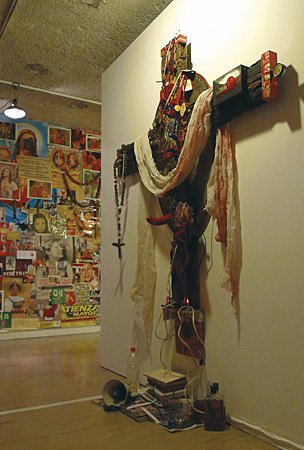Cultural Center of the Philippines
ENCYCLOPEDIA OF
PHILIPPINE ART
Poleteismo
(Polytheism) / 2011 / Site-specific installation / Variable materials and dimensions / Artist: Mideo Cruz / Bulwagang Juan Luna, Cultural Center of the Philippines, Manila / Artist’s collection
Poleteismo is an installation by Mideo Cruz that became controversial in the mass and social media in 2011 because of its usage of religious imagery juxtaposed with social, political, and popular images. It was part of the Kulo (Boil) exhibition, 2011, a project held by the University of Santo Tomas (UST) fine arts alumni in commemoration of the UST’s 400th anniversary and Jose Rizal’s 150th birth celebration. The furor and pre-terminated exhibiting of Kulo spurred by reaction to Poleteismo became a landmark incident in the discourse of art and the public, as well as on issues of intervention and censorship.
Poleteismo is a multidimensional, site-specific installation. Its exhibition in the CCP featured a three-wall assemblage of various signage, religious, political, movie, and celebrity posters of public personalities and icons, including Jesus of Nazareth, Mary, the holy family, various saints, Uncle Sam, Barack Obama, Fernando Poe Jr, Lito Atienza, as well as car plates, pin-up girls, and variable educational materials. The two-dimensional images were interspersed with crosses, rosaries, icons, Christmas lights, penis ashtrays, condoms, CDs, and various everyday objects. Included in the installation is Relics, 2004, a life-sized wooden cross juxtaposed against other icons and objects, including a gigantic rosary, an image of a bleeding hand, a piece of cloth, a UP sign, and a moveable penis. Below it are a stack of magazines, shot glasses, bottles with liquid, and a speaker. The central part of the cross has a convex mirror wherein one can see one’s self reflected upon part of the installation surface. The work thus places a likeness of the viewer within the sociopolitical critique proposed by the work. Even before apprehending the breadth of the installation, the viewer will see component parts such as Altar, 2005, a wooden altar filled with different colored plastic piggy banks, and Poon, 2005-10, a plaster of Paris sculpture of a composite image of Jesus of Nazareth and Mickey Mouse.
In terms of spatial density, composition, and material elements, Poleteismo’s precursors evolved as these were exhibited in various sites before the controversy associated with the installation at CCP. Elements of the work would be exhibited as part of Hardware 1, 2002, at the Vargas Museum in the University of the Philippines. Cruz previously used some of the components of Poleteismo in other works such as Colonial Conception, 2003, Sungdu-an 3: Making the Local, 2003, and Santong Pinagpasasaan (Ravished Saint), 2005. It also served as the backdrop of the Stonefree music video Anghel sa Lupa (Angel on Earth), 2006. Poleteismo was also a part of TuTOK: NEXUS exhibited at the ground floor lobby of the Loyola House of Studies, Ateneo de Manila University, in 2007.
None of these earlier incarnations of what would become Poleteismo elicited the charged reactions that spiraled into protest actions, public debates, a senate inquiry, and legal charges being filed against the CCP, Cruz, and Kulo’s curators while the exhibition was at the CCP. Opinions from within the art sector similarly became entangled in questions about aesthetics and the consequent visuality of critique as personalities, such as former First Lady Imelda Marcos, National Artists F. Sionil Jose and Abdulmari Imao, weighed in. For art educators, the climate for discussion underlined the wide gap in visual literacy existing between those who made art and those who encountered it. The CCP organized a roundtable discussion including members of its board, then CCP curator Karen Ocampo Flores, and the exhibition curator Jay Pacena, but it was at this juncture that a deeply divided CCP board articulated its own ambivalence about issues of accountability both to its publics and the artists who have traditionally regarded the CCP as a safe haven for both the provocative and the ideologically challenging. Heated exchanges that fueled further media coverage and public opposition, primarily from conservative Catholic sectors affronted by the parodying of venerated images, particularly of Mary, eventually caused the CCP to close Kulo. In anchoring its decision to an arson attempt, this preemptory move by the CCP to secure itself physically effectively curtailed the right of Cruz and his fellow artists to exhibit their works for the whole duration of the CCP exhibition contract period.
Written by Maria Portia Olenka C. Placino and Maria Eileen Legaspi-Ramirez
